
Translated from “Grundsätze vorzeitlicher Kultgeographie”
Comptes Rendus du Congrès International de Géographie, Amsterdam, 1938, Section V, 90–108.
Heinsch, a regional planner in Germany, developed his landscape-geometry theories in the 1930s. He published them in various places, the most accessible being this paper delivered to the Geographical Congress in Amsterdam in 1938. His theories became known to the Straight Track Club in England, and an English translation by R.P. Jones (which I have not seen) was summarized in F.C. Tyler’s book The Geometrical Arrangement of Ancient Sites; from there Heinsch’s theories were quoted in John Michell’s influential work The View Over Atlantis (Sago edition, 1969, p. 21).
Having access to the original paper and some (but not really enough) knowledge of German, I made this English translation in 1973. It was published first by Zodiac House (Anthony Roberts) and again in 1977 by Fenris Wolf (Nigel Pennick). In those publications the diagrams were redrawn; this Web version restores the original diagrams, with some relettering in the English translation.
Grundsätze vorzeitlicher Kultgeographie

Moers (Rhineland)
To many people a systematic geometrical arrangement of communities and landscapes by our “primitive” native ancestors may seem out of the question in evolutionary history. But even under strictly rational consideration this surprising fact loses its incredibility when one realizes that the surpassing skill displayed by prehistoric people in Ice Age art is undisputed today, although only 50 years ago the Anthropological Congress in Lisbon declined even to look at the Altamira cave paintings – now universally admired – as being simply unbelievable, and thus delayed by several decades the recognition of their discovery, which according to Kuhn (Kunst und Kultur der Vorzeit Europas, Berlin 1929) “overturned all established beliefs”. This mention of the singularly “accomplished, artistically and technically perfect” paintings of “primitive cavemen” is made here for two reasons. Not only does the memorable story of their discovery show the importance of being unbiassed – “first evidence, then verdict” – but above all the unusual ability to understand and manipulate form shown in the art of Ice Age people, whose “magical view of nature” was so different from ours, can lead even the sceptical clearly to appreciate the no less surprising discovery of a prehistoric sacred geography.
As far as geographical science is concerned, the present results of research carried out in this field by the author, in several years fruitful collaboration with Father Joh. Leugering M.S.C.Missionarius Sacratissimi Cordis (not M.Sc. as in 1977 edition), can essentially be reduced to the following seven basic principles:
1. Far back in prehistoric times, probably when people first made agricultural settlements in the Stone Age, large tracts of land were already being accurately divided and surveyed.
2. This ancient geometrical arrangement of the country appears to have been started and carried on uniformly over a wide area – in the Orient as well as in the north of Europe – accordingly to (a) certain fixed angles (azimuths measured from the astronomical N–S axis) and (b) equally universal measures of length.
3. The metrological laws discovered in landscape patterns correspond according to angle, length and number to the proportions that were later retained in canonically-constructed sacred buildings – northern stone circles and oriental temples as well as Christian churches – and are still effective today in giving them a cosmic-sacred quality.
4. The sacred art of metrology based on “primitive” peoples’ clear insight into nature (the “magical” view of microcosmic–macrocosmic correspondences), with its application to the geometrical arrangement of the landscape, is hardly inferior in accuracy to the technical achievements of modern surveyors. It originally covered all sites of any importance, in particular sacrificial and assembly places in addition to boundary marks.
5. Allowing for the varying importance and purpose of these sites, their orientations to one another followed according to universally valid rules, starting throughout from the exact N–S axis, the “Law-Tree” of the Edda, and the ancient “holy hills” as the chief sacred centres. Because of the general conservative retention of pagan religious sites, and their occupation by churches, chapels and mosques to bring them into line with Christianity or Islam, the pattern is recognizable in its main features even today, and gives a characteristic local stamp to the structure of a country or landscape.
6. Apart from the fundamental triangulation of the country based on 30° and 60°, and the orientations on the diagonal of a square (45°) or double square (about 26.5°), the main sacred angles determining the ancient geometrical arrangement of the landscape are as shown in:
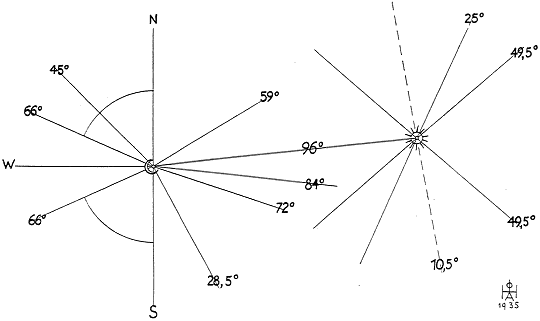
Fig. 1. “Basic plan of the holy hill / solar site orientation” 1)
1) = Fig. 2 of the offprint from Allgemeine Vermessungs-Nachrichten: Dr. Heinsch, Vorzeitliche Ortung in kultgeometrischer Sinndeutung (25 pages with 25 figures, obtainable from Wichmann-Verlag, Berlin, Karlstrasse 14 for 1.10 Reichsmark).
The base line of this system of orientations links two important sacred sites which are found to occur regularly: (a) the holy hill in the west, originally associated chiefly with Moon-worship and in Christian times often dedicated to Our Lady; and (b) to the east of this on 84° or 96° – with a 6° deviation to the north or south – the former solar site, in Christian times often dedicated to St. John the Baptist. Since in the mathematics of the ancients this base line, with the angle of 6°, appears in a right-angled triangle with short sides in the ratio 19:2, the square on the hypotenuse thus being 365 (= 192 + 22), the line was given the name of “solar year line” (Fig. 2).

Fig. 2. From the holy hill to the solar site leads the solar year line. 19:2 = √365.
7. Not only in the ancient layout of the landscape, but also in the religious buildings erected later, the original unit of length turns out to be the metre, which was first profaned in the French Revolution, and as a ten-millionth of the Earth’s quadrant is cosmically defined. The oldest basic units of length, in northern and eastern countries can generally be referred back to the metre by ratios involving whole numbers – especially multiples of 7 as measuring the diameter of a circle and multiples of 11 as measuring the circumference (with π expressed in terms of whole numbers as 22/7).
Let us now give some examples to show that these assertions are well-founded: first in respect of the last statement about the metre as a universal basic measure.
It is not simply chance that the diameter of the largest stone circle at Odry in West Prussia (now PolandN 53° 53′ 54″, E 17° 59′ 35″; not Odry in Czechoslovakia as in 1975 & 1977 editions, and also of the reconstructed Stonehenge, is 31.5 m (circumference 99 m), exactly three times as wide as the Holy of Holies in Solomon’s Temple. This has a width of 20 royal cubits of 0.525 m, or 110.5 m in all, the perimeter of the inscribed circle being 33 m and of the square 42 m (see Figs. 3 and 4).
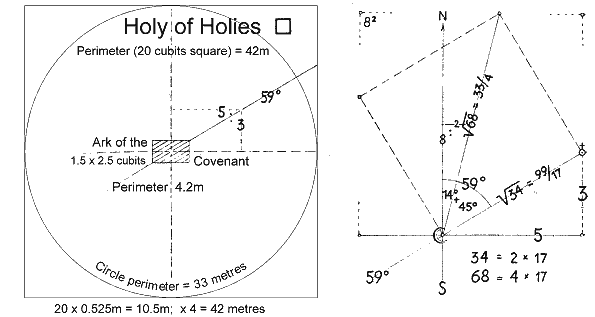
Fig. 3. Square of the Holy of Holies, Ark of the Covenant, and holy hill orientation.
Same metrical relations in sacred buildings as in the old spatial ordering of the landscape.
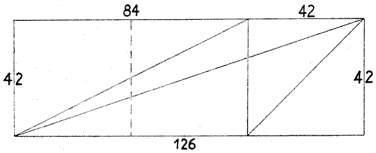
Fig. 4. Square, double square and triple square, the basic shapes of old sacred buildings, with the holy hill number 42 in metres the ground plan of Notre Dame de Paris.
The venerable church of Notre Dame in Paris measures, according to the Norwegian Macody Lund (Ad Quadratum, Paris 1922), 42 m in width, with a length 3 times as great, and vertical stages of 11, 22 and 33 m; and the dome of St. Peter’s in Rome, with a diameter of 42 m, was certainly not built “measurelessly” by master-builders like Bramante and Michelangelo. The twelve largest pillars in the aisle of the Temple of Amun at Karnak are 21 m high; and even in the ground-plan of a recently excavated temple or palace at Uruk-Warka in Iraq, dating from the first flowering of Sumerian culture, there is a square of 21 m such that on its division into 42, giving a basic unit of ½ m, the dimensions of the walls and the interior measurements become whole numbers throughout.
Now 42 is the number measuring the holy hill, as 84 is that for the summit, not only according to Kirfel’s Kosmographie der Inder (Bonn 1920), but what is more by the common agreement of various old religious traditions. In Egypt the kingdom was divided into 42 provinces, and 42 judges of the dead decided whether the departed souls were innocent of 42 sins. Even in the Bible 42 occurs in several notable places, e.g. Judges 12:6; 1 Kings 9:28; Revelation 11:2; 13:5; and Christ himself conforms to the rule of 42, as is shown by the very first chapter of the New Testament with its enumeration of his 3 × 14 line of descent. And similarly in the northern tradition of ancient revealed wisdom there remained the knowledge of a 42-stage descent and re-ascent from the heavenly to the earthly, preserved in the astrological poem Grimnismal (in the Edda), which also gives a total of 42 mysterious by-names for Odin; while even in the down-to-earth traditions of the Sagas it is still said of Wotan’s wild huntsmen: “There were 42 of them”.
After the agreement of this evidence, it seems only natural that the stone circles at Odry should contain as the centrepiece of the pattern a clearly-defined double square of exactly 42 × 84 m, passing through the centres of circles III, IV and X and also the tops of hills 8 and 5, as shown in Fig. 5:
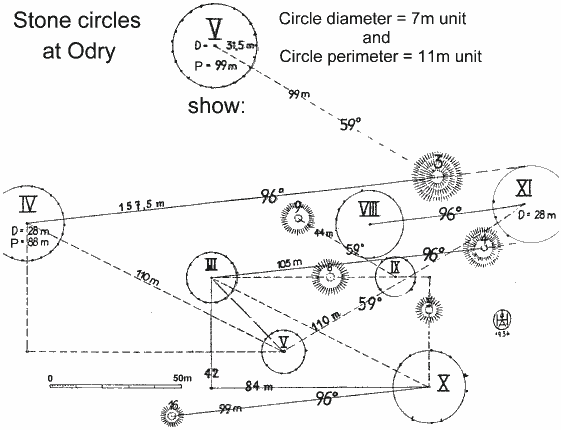
Fig. 5. To sacred angles belong cosmic measures of length: developed in metres from Nordic stone circles.
Thanks to the accurately-drawn N–S axis on the 1:400-scale plan, which was made by the government surveyor Stephan before the War and became available to me in summer 1936, the sacred angles of the “holy hill/solar site orientation” previously found from a survey of the landscape and published with the “basic plan”, could also be shown to exist in this prehistoric layout in remarkable profusion and distinctness. The map reproduced here shows only part of the results; for example:
The circumference of the largest circle V (diameter 31.5 m) is laid out on the 59° azimuth as a straight line exactly 99 m long, leading from the centre of the circle to the summit of the highest hill 3. The 59° angle appears again in the line of length 44 m joining the centre of circle IX to the summit of hill 9, and a third time (running mirrorwise) in the line of length 110 m joining circle II (inside the central double square) to the easternmost circle XI. Regularly going out from the chief “holy hill” centres, the 59° azimuth appears repeatedly in the landscape, associated with the right-angled triangle of short-side ratio 3:5 (that of the golden section, or sectio divina), thus, in agreement with the Ark of the Covenant, which is a rectangle of 1.5 × 2.5 royal cubits having a perimeter of 2 × 4 × 0.525m = 4.2 m or one-tenth of the perimeter of the square Holy of Holies.
Of the four parallel 96° azimuths (so-called “solar year lines”) shown in Fig. 5, the one that runs from the top of hill 16 to circle X again shows the “circumference length” of 99 m; while the ones from circle III to the top of hill 4, and from the centre of the westernmost circle IV to the hill 3 mentioned above, “diameter lengths” of 105 m and 157.5 m. Here again the agreement between the linear measures used in northern stone circles and the proportions of eastern temples is unmistakable; 99 m is 3 times the circumference of the circle inscribed in the Holy of Holies, 105 m is 10 times its width, while 157.5 m is 15 times this width, and at the same time exactly coincides with the length of Noah’s Ark (300 royal cubits of 0.525 m).

Fig. 6. Equal lengths in the East and North: 300 cubits = 157.5 m.
But above all 157.5 m is also equal to the Egyptian stadium (1/40 schoinos = 1/40 x 6300 m = 157.5 m) of Eratosthenes (d. about 200 BC) who is famous for the first recorded measurement of the Earth. In connexion with this length, Konrad Miller, the expert re-editor of the oldest maps of the world (Die Erdmessung im Altertum und ihr Schicksal, Stuttgart 1919), has no doubt that Eratosthenes worked with the equation 1° = 700 stadia, i.e. with one-sixtieth of the circle = 4200 stadia and then with the division of this fraction into sixths.
It may be added that “the schoinos as a unit of length in Parthia is computed by Herodotus to be 60 stadia = 11 km”. And that the same basic length of 11 km has been the standard for the triangulation of the countryside in ancient Germany. Luckily this also has documentary proof in the following piece of literary evidence: Adam of Bremen, historian of the christianization of Northern Europe, and also important as a geographer, reports in his Gesta Hammaburgensis ecclesiae Pontificorum I, 1 that Saxony, to those who measure it correctly (“recte metientibus”), turns out to be a triangle (“trigona”) of which the western angle (“angulus primus”) lies by the Rhine “a bowshot away from the river”, the eastern 8 days” journey away on the Saale, and the northern in Haduloh.
As long ago as 1875 the archivist Böttcher (Diöcesan- und Gaugrenzen Norddeutschlands, Vol. 1 p. 64) accurately identified the “angulus primus” on the Rhine as the boundary-marking bend “on the Rubbert” near Dinslaken, 200 m away from the former river bed; and recently Fr. Leugering (Hummlings-Emsland; Johannesburg, 1936, p. 21) has gone on to show that a line of length 8 × 44 km = 352 km (8 “rasten”) running eastwards from this western vertex leads to the River Saale, and that the north point of the “Saxon triangle”, the modern Hadeln (Haduloh), lies perpendicularly above the mid-point of the W–E line, thus forming an isosceles triangle. It is especially remarkable too that he found the cathedral of Paderborn to lie 33 km, and that of Minden 22 km, west of the N–S axis of the Saxon triangle.
The historian Adam mentions simply, and as something taken for granted, the “recte metientibus” who knew of “cardo” (Haduloh) and “decumanus” (from the Rhine to the Saale) in the fundamental triangulation of Saxony with its base length of 8 × 44 = 352 km; and it follows readily that such experts in landscape surveying must themselves still have known the ancient principles by which the land was marked out and ordered on this vast scale – principles which must come down from a time when a religious view of the world led to the shaping of peoples and places into a truly organic whole, through a pattern linking the now settled members of the community in space as well as in time and in way of life.
How much these traditional principles of “sacred engineering” were still valued and cherished everywhere is shown not only by the churches, chapels and crosses which were set up on the most important sacred sites of the country, but most of all by the retention in Christian form of festival processions, annual circuits, and periodical beatings of boundaries, which, fixed in time by their places in the yearly calendar, were and are tied spatially through the ancient layout of the country to certain unvarying locations. Far into the Middle Ages the sacred principles remained intact, and the first cities to be founded against the rules were despised as coming “from wild roots”, i.e. as illegitimate and therefore not of true stock. In many parts of Germany a knowledge of our ancestors’ unwritten rules for determining sites and boundaries lived on – however degenerate – into modern times. Particularly in Westphalia, the heart of ancient Saxony, even the correct practical application of the traditional principles seem not to have died out until the decline of the “secret Veme”. At all events it must have had a decisive influence on the ecclesiastical and secular authorities there, even as late as the 17th century, since in the settling of protracted legal disputes about old boundaries there are still documentary reports on the preparation of the verdict by special experts who, “among various strange things”, worked in mysterious seclusion on the ancient measuring points of the country.
As stated in a document of 1490 and confirmed by the Westphalian legal code of 1546, the “free jurors” of the official Veme had to be “up roder Erde gemaket”, i.e. made on red earth. And today Westphalia, famous for its obstinate clinging to the rule of the Veme without any higher authority, is in all parts of Germany called “the country of the red earth”. This name was not (as one might think today) originally connected with the colour red at all, but with the ancient layout of the landscape; it is land which is sacred, because measured with “roden” (modern German “Ruten”, rods, in the two senses of sticks or units of length). The old “rode”, which remained in official use in Denmark until very recently as a length of 0.314 m (circle diameter for 1 m circumference!) was a fundamental unit of the old “sacred engineering” stamped almost indelibly on the face of the country. And in Westphalia a man was not accepted as a lawful judge in the daily “free courts” which met “in the open air, mostly under lime trees”, unless he had been duly invested on the places of jurisdiction fixed for the purpose by accurate surveying. In this temporal scheme, derived in former times from the divine, everything was subject to the “rule of measurement”.
This reference may serve as both proof and example of how the traditional place-names – always guides for researchers – speak plainly of the old geometrical arrangements; and thus how research into place-names, with a proper understanding of the rules of orientation, could one day achieve a deeper significance and become the basis of a really worthwhile topographical science.
In Germany, even restricting ourselves to the “rode” examples given above, the thousands of place-names with the syllables rode, rade, rot and rat (found from a practical investigation in widely differing parts of the country) would serve as so many starting-points and guides for systematic research, not only to extend our knowledge of the original regional divisions and hence of the principles of landscape formation, but also to build up, by a far-reaching comparison of the local traditions with the proportions of the orientations, a clear picture of the original purposes of the sites, whether it was for sacrifices at certain fixed times of the year, army levies, law sessions, rights of way and water, or the use of woods, meadows and arable land.
In other countries exactly the same considerations will hold, since the principles of orientation – though naturally showing at times purposeful and ingenious adaptations to the conditions of the landscape or the needs of the community – have already been shown by pilot studies in England, France and Palestine to be applied with surprising uniformity and with agreement over a wide area.
In these circumstances the rediscovery of the old geometrical arrangements of the landscape, of which only the first stages and a few essential principles are described here, may be given a not unimportant role in the formation of a new science of landscape arrangement suited to the needs of modern communities, provided that care is taken to build up organically from firmly established ground, and not to block the springs of power arising from popular and national traditions but as far as possible to take fresh hold of them and keep them clear.
As legal representative for the region, the author himself played a leading part for ten years in the drawing up of a general housing plan, with its functional divisions into areas, provision for green-belts, transportation corridors, extension of the road system etc., for the second largest of the German rural districts then undergoing heavy industrial development. So he well knows how difficult it is to do justice, with care and forethought, to legitimate demands for the protection of the local people and their traditional way of life, as well as to the greater degree of civilization required by our advancing technology and the development following from it; and that in practice it is necessary to have an intimate knowledge of countryside and people – the basis of their agriculture, their family ties, in fact a many-sided sympathy with the local character – in order to protect this warm-blooded life against its unwanted disruption by the spread of gigantic machinery, the narrow-mindedness of cold intellectual calculations, and the all-too-tempting paper schemes of distant planners. If ever the threatened local interests are to be strengthened and preserved by recommending the modern landscape-shapers to make use of the discoveries described here, it is necessary above all firmly to convince those so inclined that a test of these principles, as laid down especially in the basic plan of the holy hill/solar site orientation, does not just provide a few interesting clues and fresh ideas in regional studies but regularly leads to quite new, though scientifically sound, results by which important features of the surviving landscape structure can be recognized even today.
That this is true follows from the fact that the universal validity of the principles described here has always been verified whenever the necessary materials could be made available for the region in question. These are:
1. A suitable official map, equipped with grid lines, on which the true N–S axis must be clearly indicated. Maps to a scale of 1:50 000 (2 cm : 1 km) give the best results, because they both are accurate and extensive enough to provide, on a single sheet, a fair number of datum points whose positions can be accurately measured.
2. Clear indications of known ancient religious sites (churches, chapels, crosses) as well as spots noted for their historical or legendary traditions. These places are best indicated by ringing them in red. By the addition of a number, further remarks about the significance of each place, e.g. characteristic names and especially Christian dedications and festivals, can be easily and clearly noted down on an attached list.
It should be obvious, not only to sceptics, that the results of these investigations on the map should be checked, filled out and supported by a local topographical and historical study, in order to interpret the metrological relations between the alignments in different places in terms of a single whole, and thus produce fully ripe fruit on the tree of scientific knowledge. But from a common-sense point of view, the combined evidence of the regular sets of orientations that come to light is usually such that the obvious harmony of angle, length and number rules out from the start, on statistical grounds, the assumption of what would be a miraculous coincidence.
The investigations on the map have recently reached virtual certainty through the discovery, made after a thorough investigation of the proportions of the stone circles at Odry, that the original fundamental orientations frequently turn out to be arranged in parallel lines according to definite rhythms of measurement.
The observation that the fourth of the 96° parallel lines in the Odry complex (Fig. 5) from the centre of circle VIII to the centre of XI, is just half way between the lines from the centre of IV to the summit of hill 3 and from the centre of III to summit 4, and that when extended these last two lines are tangents to circle XI of diameter 28 m, led me to investigate the N–S distances between the 9 “solar year lines” (reproduced in the diagram below) which I had found a few weeks before on the lower Rhine. The values found, as shown in the diagram and read off correct to 1 mm from the 1:50 000 map, are clearly multiples of 700 m.
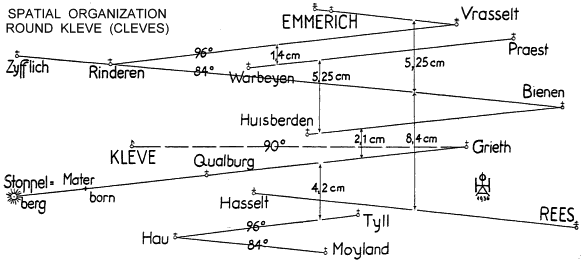
Fig. 7. 17 Christian religious sites, and the Stoppelberg in the Reichswald Forest, on 9 clear solar year lines at precise 700-m distances.
Similarly there turned out to be complete agreement between the distances in the landscape arrangement and those in the stone circles for the angle of 10.5°, on which incidentally scientific evidence shows the axis of the well-known stone rows at Callanish in Scotland to be aligned. At Odry this angle turned up twice: first from the centre of circle V to the top of hill 10 and again from the centre of VIII to the centre of XII; each has a length of 72 m and moreover, these two parallel lines have an E–W separation of exactly 72 m! The lines previously determined on the west German map round Kleve, joining churches at Warbeyen and Bedburg, and Dornick and Kappeln, both on 10.5°, were likewise found to have an E–W separation of 14.4 cm or 7.2 km!
The head of the official Land Registry Department in Kleve, Surveyor Rensing, comments on this in the Allgemeine Vermessungs-Nachrichten (1937, p. 394):
“As for the test of the solar year lines, angles, and distances that Dr Heinsch has discovered near Kleve, I can only confirm their accuracy. I was astonished: even calculations from grid references showed that the accuracy, if not quite mathematically exact, was still remarkably good, considering that the lines (84° and 96°) do not pass through the existing church towers but through the former prehistoric Germanic religious sites, on which the churches were later built (N.B. around the altar!) I should like to emphasize strongly here that apart from hills and important landmarks we are dealing, in the case of the churches mentioned, with primeval lower-Rhine sites that were already significant in the early days of Rome.”
The 700-m interval between solar year lines, of which the account given here must be restricted to the essential points, I have meanwhile found to be confirmed particularly often: not only in Germany where a particularly impressive example is the “old landscape arrangement near Munich” – based on the first map drawn by modern surveying, on a scale of 1:50 000 and dating from 1812. As can be seen from the map laid before the Congress, there are to be found there, in an area of 25 × 35 km, a total of 63 old religious sites in regular relationships with one another. As well as six particularly noticeable triangulations on 30° or 60°, ten orientations on 66°, eleven on 49.5° and seven on 10.5°, there appear thirty solar year lines on 84° or 96°, of which several also have regular N–S intervals of 10, 9, 8 and 6 times 700 m. Moreover, from the original holy hill, now the site of the altar in St. Mary’s, Pasing, there run out seven orientations on regular angles; on 96° lie the churches of Englschalking (14 km away) and Poing (27 km) and on 84° St. Peter’s, Munich, with the altar point at an equally exact distance of 9 km; surely a remarkable proof once again of the fundamental significance of the metre.
That the theory is also valid for France is shown clearly and beyond doubt by the four sheets of the official 1:50 000 map for the neighbourhood of the world-famous Chartres Cathedral, which is also dedicated to St. Mary and is built on a very ancient sacred site. Its former role as a holy hill is confirmed by various regular orientations to nearby churches. In particular the associated solar site lies on 84° and exactly 6.5 km away, marked in Christian times by the church of Nogent-le-Phaye. At the point of intersection of the 59° line from Chartres and the 10.5° line from Nogent-le-Phaye stands Gasville church. From here the 96° line leads to Levainville church; and 16.8 cm (8.4 km) to the north runs a parallel line joining the churches of Yermenonville and Sonchamp. South-west from Sonchamp (on 25° and exactly 7.5 km away) lies Ablis church with many regular orientations: e.g. at 84° to Gallardon church (and the chapel near Berchères), and 11.2 cm (5.6 km) to the south the line joining Umpeau and Paray-Douaville churches runs parallel.
Exactly 8 km west of Roinville is Houville church which, as the southern vertex, forms with Chartainvilliers and Ecrosnes churches, obviously E—W from one another, an equilateral triangle of side 13 km. These are just some of the easily seen examples on the map Chartres S.E. (see Fig. 8).
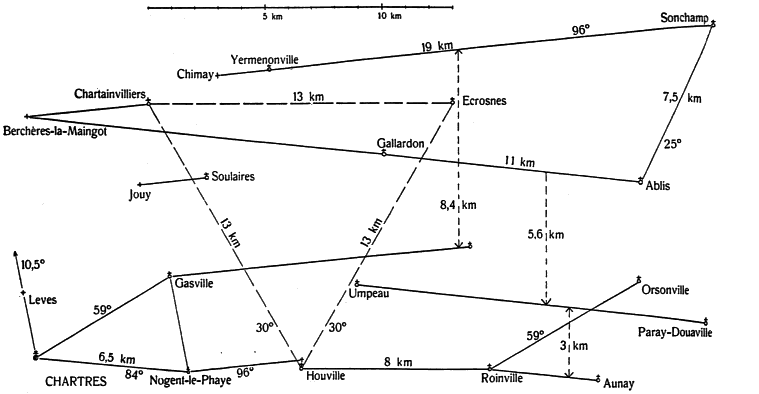
Fig. 8. Example of regular ordering in France going out from Chartres Cathedral: 9 solar year lines with significant north–south distances, and a 13-km triangle.
At 10.5° north-west of the cathedral, 6.8 km away, lies Poisvilliers church with a 96° orientation to the church of St. Arnould des Bois, and 11.2 cm (5.6 km) to the north runs a parallel line exactly 11 km long joining the churches of Gâtelles and Challet; while 4.2 cm (2.1 km) to the south a third parallel runs from Landelles church to a centre in the Bois Bailleau remarkable for its many regular relationships.
South-west of Chartres, Notre Dame des Chatelliers is shown to be a “holy hill” site by seven regular orientations. The associated solar site, on 84° to the east, is the church of Ermenonville-la-Grande. Among several lines parallel to this (2) that from Formeste chapel to the church of Pont-Tranche-Fétu shows a regular N–S interval of 7 km, which is divided into 3 + 4 km by (3) the line joining the churches of Bailleau-le-Pin and Mignières, while (4) that between the churches of Méréglise and Vitra-en-Beauce lies 6.5 km further to the south, and (5) Blandainville to Luplanté (with a N–S interval of 4.4 km) is seen to follow the rules by many orientations, e.g. 30° to Mignières and 66° to Ermenonville.
This investigation, based entirely on what is shown on the map, has yielded at least 36 convincing examples of orientations between churches and chapels: within a 25 km radius of Chartres Cathedral.
In order to investigate further the range over which the old geometrical arrangements appear, a corresponding pilot study was recently made in Palestine; for this sheets 59 (Nablus) and 60 (Lubban), the last still to be available commercially of the German 1:50 000 map of Palestine produced in the World War and based on that of the Palestine Exploration Fund, provided a lucky starting-point.
The investigation began with the peak, indicated by a triangulation mark, of the biblical Mt. Garizim near Sichem (Nablus). Apart from orientations on 59° and 66° to nearby mosques, the most remarkable lines are on 45° (the diagonal of a square) leading out from this sacred centre of the land of Canaan, significant even before Abraham’s immigration, both NW and SW to important sacred sites about 8.5 km away and still occupied by mosques: (1) Sheikh Ibrahim el Adham in the NW, when joined to the mosque at Kubebet ed Dahr 8 × 700 m away and to Kasr el Fuhes another 7 km to the north, indicates the N–S axis of the main metrological pattern on Sheet 59; while (2) Alim el Hada in the SW, when joined to Sheikh Katrawani 17.8 km to the south, forms the corresponding N–S axis on sheet 60 (Lubban) – to which, in the interests of brevity, the presentation in note form of a few further results of investigations on the map must be restricted.
It appears that in this 24-km square region lying between Jerusalem and Sichem the same principles of angle, length and number are followed as those that have been shown to exist over much of northern Europe from time immemorial:
A. First of all the religious sites mentioned are shown to be old centres by (1) regular orientations on the diagonals of double squares with dimensions clearly equal to 42 × 84 mm, 52.5 × 105 mm, and (twice) 33 × 66 mm,
(2) triangulations on 30° and 60° seven times, and
(3) eight-rayed alignments on 90° and 45° also seven times: and these also often at obviously regular distances apart.
B. Nine lines in this region can quite clearly be considered as solar year lines, among them (1) four on 84° with regular N–S intervals of 8.4 km, 1.6 km, and 5.6 km, and (2) four on 96° with N–S intervals of 8 km, 4 km and 2 km.
C. Three alignments were found on 10.5°, each connected with a solar year line, with lengths of 16 km, 11 km, and 15.75 km, and two of these had an E–W separation of exactly 4 × 700 m!
D. This 700 m periodically appears with quite surprising clearness in the nine lines found to date linking religious centres on 49.5° (the angle of a 6:7 right-angled triangle). (1) Five of them run from NE to SW with E–W intervals of 126 mm and 125 mm (both twice).
(2) Four run (mirrorwise to the others) from NW to SE with E–W intervals of 105 mm (twice) and 140 mm (once).
(3) Five of them also show definite multiples of 700 m along the line itself.
In northern Europe these 49.5° inclinations, like the solar year lines, are impressed on the landscape hundreds of times, and usually in connexion with them. Thus for example they appear 10 times on the lower Rhine near Kleve: invariably in connexion with the seventeen Christian sites that lie on solar year lines, and again in the region of Chartres they are not infrequently found in similar regular relationships.
In the stone circles at Odry I have so far seen this sacred angle used only once: running from the centre of the easternmost circle XI through the exact mid-point of the southern side of the central 42 × 84 m double square (and therefore through the centre of an 84 m square) and going on further through the top of hill 17, which is the centrepoint of a twelve-rayed orientation (on 30° and 60°).
But for a proper understanding of this angle’s fundamental sacred importance we must above all look to Stonehenge with the axis of its structure aligned NE–SW on 49.5°, especially since it is the origin of the prehistoric discoveries and new branch of geography developed here, and served as a firm basis for them from the outset.
When around the turn of the century the English astrophysicist Lockyer was investigating the orientation of this “Stone-age Sun Temple” on the midsummer sunrise, it was pointed out to him by the Director-General of the Ordnance Survey in Southampton, Col. Johnston, that in line with the axis of stone circle and its continuation as the Avenue there stood three other well-known ancient sites – Castle Ditches, Grovely Castle and Sidbury Hill, and their alignment over a distance of 33.4 km was found to be so amazingly exact that the survey of the region was accordingly improved. At the same time, moreover, following the discovery of an equilateral triangle with sides of 9500 m the further notable distances of 3200 m and 8400 m were indicated on a line at 10.5° to Old Sarum, Salisbury and Clearbury Ring (see Fig. 9).
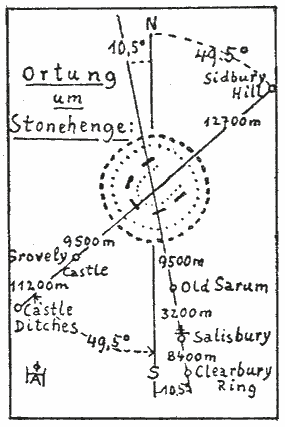
Fig. 9. Sketch of Lockyer’s determinations of angle and length around Stonehenge;
after Albrecht in „Das Weltall” Berlin 1914/15.
It is to the credit of the survey-engineer Albrecht, later killed in the World War, that by a discussion on “Stonehenge” in the periodical Das Weltall in 1914/15 he brought these remarkable observations to the notice of Father Leugering (as he is now) on his return home in 1920 from imprisonment in Russia, thus prompting him to make a successful search for similar orientations (in the sense of the so-called “Kulturkreis-theorie”) in his Westphalian homeland.
A half-inch map with clear grid markings, fortunately still in my possession after a previous visit to the district, enabled me to demonstrate conclusively the equal validity for England of the principles of the holy hill/solar site orienation discovered by wide-ranging investigations in very different regions of Germany. In the region round Stonehenge and Salisbury there appeared e.g. sixteen convincing solar year lines organically related to one another. In particular, assuming that the old sacred places on the 49.5° line through Stonehenge are former solar sites, there appeared as the corresponding “holy hill” sites to the west, with a regular 6° deviation: (1) for Castle Ditches the churches at (a) Bourton and (b) Gillingham, (2) for Sidbury Hill the chapel at Fittleton, and (3) for the centre of Stonehenge itself (a) Scratchbury Hill and (b) Codford Castle. The last 96° joining line runs further east to (c) Quarley church, while the 84° line, according to the plan in Stevens, Stonehenge Today and Yesterday (London 1927, p. 31), leads (d) from the centre of the stone circle to the peak of the round hill to the east.
Salisbury Cathedral is admittedly not – according to Albrecht’s diagram – aligned with sufficient accuracy on 10.5° to Stonehenge, but rather to Old Sarum. The site is a presumed old solar centre lying eastwards on 96° from Chiselbury Camp; and from the chapel at Misselfore, lying due south of this “holy hill” site, a 96° parallel line also runs to Clearbury Ring (see Fig. 10).
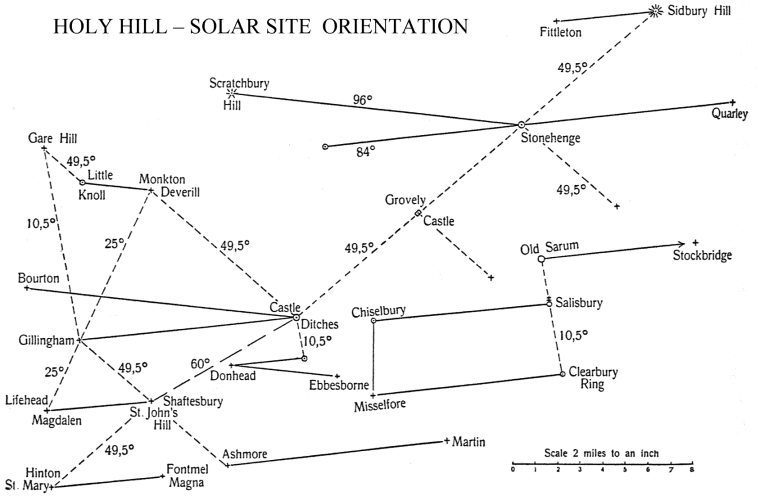
Fig. 10. Solar year lines worth investigating in connexion with Lockyer’s 49.5° axis;
after the official half-inch map of the Southampton area.
The important thing about the principles of prehistoric sacred geography, which have been illustrated here only by a relatively small set of impressive examples, is their general validity and enduring recognition, so that it is possible for anyone to test them for themselves by a scientific investigation – not at all difficult – of the district familiar to them; and the author can freely offer his co-operation if necessary in a complete demonstration, as long as he is provided for the purpose with maps fulfilling the conditions above.
It would be particularly desirable, for a further investigation of the range over which these gigantic hieroglyphs occur, if competent geographers, not only in European countries but also in Asia (China, India, Polynesia), Africa and even America, were to make a test, or at least make the materials available, to see whether the principles explained above apply to the ancient surveying and marking-out of the country which, considering the fundamental agreement in the oldest temples and other religious structures, is to be expected there also.
These novel scientific results towards a clearer view of local and general prehistory naturally involve various problems which cannot properly be discussed here, particularly about the actual meaning of the patterns of orientations and periodicities in measurement. To counter the natural and reasonable doubts about the possibility of such a widespread and uniform arrangement of the landscape by people at a primitive level of culture, let us just make the further remark that it is not at all a question of “technical” organization as we understand it to-day, but the expression of an “absolute sense of space” in so-called “magical” people, which was everywhere “orientated” on the north–south axis. The clear recognition, which has recently come from scientific anthropology and psychiatric research, of the fundamental difference between the magical outlook of “homo divinans” and the technological thought of “homo faber” has for the first time made it possible for our alien consciousness properly to appreciate the surprising evidence for a highly spiritual culture in former generations: for example, the art of the Ice Age, and especially the now undeniable fact that their sense of order – unmistakable even today – has bestowed on our native landscape an almost indelibly sacred individual stampWesenstempel (the “temple” in earlier editions is a mistranslation).
Therefore these principles of an ancient geometrical landscape arrangement, which are imprinted everywhere and which seemed like natural laws to the “natural insight” of their originators, must not be treated merely as the antique hieroglyphs of a vast “primitive handwriting”, still legible, with the help of measure and angle, in the landscape today. They should above all be recognized and evaluated as the ground-plans for a certain configuration of land and people, which with its geometric proportions – “pleasing to God” as well as man – works today as effectively on our natural human feeling for our homeland as do the same proportions in Gothic cathedrals and other old buildings reflecting the cosmic order, which even now somehow put the silent beholder in harmony with the infinite, impressing him spiritually and thus influencing him “magically”.
The author, who by profession and inclination is accustomed to a practical way of life, would at any rate like to offer, along with these fruits of seven years research, warm encouragement and practical help in the study and where possible the application of these fine “true-born” principles of a popular landscape arrangement, which has grown up and been preserved over thousands of years; so that even the reconstruction necessary in our own times can be made to harmonize naturally with the landscape through the “canon of measure” inherent in all true human art.